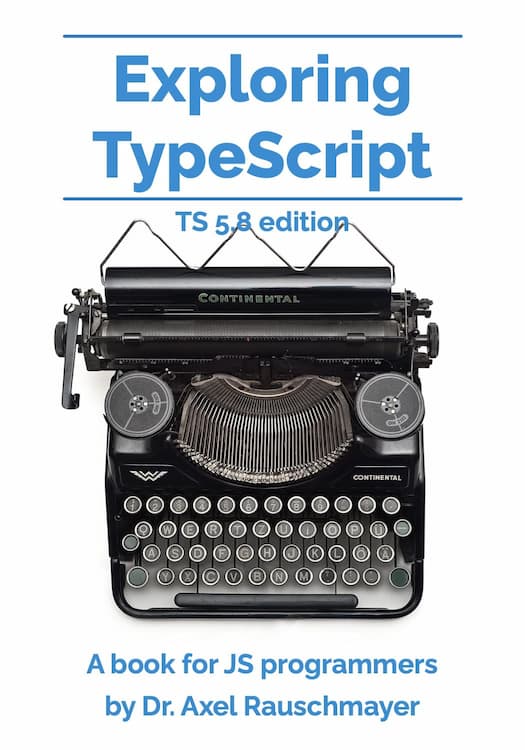[Web dev for beginners] Arrays in JavaScript
This blog post is part of the series “Web development for beginners” – which teaches people who have never programmed how to create web apps with JavaScript.
To download the projects, go to the GitHub repository learning-web-dev-code and follow the instructions there.
I’m interested in feedback! If there is something you don’t understand, please write a comment at the end of this page.
In this chapter we look at one way of storing more than one value in a variable: arrays.
Arrays: storing more than one value in a variable
If the values we have encountered so far (numbers and strings) are single sheets of paper then an Array is a stack of sheets of paper. Let’s explore how arrays work:
Let’s create an array and assign it to the variable arr:
> const arr = ['a', 'b', 'c'];
We have created an array that contains three strings. The syntax works as follows:
- It starts with an opening square bracket,
- is followed by the array’s elements (which are separated by commas) and
- ends with a closing square bracket.
The syntax for creating an array is called an array literal. We have already seen other kinds of literals:
- Number literals:
5,-2,6.1, etc. - String literals:
'', 'abc', etc.
How many elements does the array in arr have?
> arr.length
3
Array elements are accessed via indices – numeric positions that start at zero. We can read elements:
> arr[0]
'a'
And we can write elements:
> arr[0] = 'x';
> arr
[ 'x', 'b', 'c' ]
The index of the last array element is always .length minus one:
> arr[arr.length - 1]
'c'
A value that contains other values in an easily accessible way is called a data structures. An array is a data structure.
Arrays are mutable, even with const
Why can we change the array if arr is a const variable? const only prevents us from putting different values into the box that is the variable. If the box contains a value that is mutable (can be changed) then const does not prevent us from changing that value.
Note that numbers, strings and undefined are all immutable – they can’t be changed, only replaced. For example, the following code does not change the number that’s stored in the variable num – it puts a new number into the variable:
let num = 0;
num = num + 1;
Single-line comments vs. multi-line comments
The // comment is called a single-line comment because it exists in a single line. There are also multi-line comments: Their ends are marked explicitly and they can span more than one line:
/* Multi-line comment that fits into a single line */
/* Multi-line comment
that spans
three lines */
For aesthetic purposes, multi-line comments are sometimes written as follows. Note that that doesn’t change anything for JavaScript: It still simply ignores what’s between /* and */.
/*
* Multi-line comment
* that spans
* five lines
*/
Project: magic-8-ball.html
Let’s implement a Magic 8 Ball app: The user comes up with a yes-no question in their mind. After they push a button, the app displays an answer. The user interface looks as follows in HTML:
<ol>
<li>Ask a yes-no question!</li>
<li><button id="answerButton">Click to show answer</button></li>
</ol>
<p id="answerPlaceholder"></p>
The <p> in the last line is a blank that we eventually fill with an answer via JavaScript.
This is an abbreviated version of the JavaScript code:
const answers = [ // (A)
'It is certain',
'It is decidedly so',
// Etc.
];
const answerButton = document.querySelector('#answerButton');
const answerPlaceholder = document.querySelector('#answerPlaceholder');
answerButton.addEventListener(
'click',
() => { // (B)
const answerIndex = getRandomInteger(answers.length);
const answer = answers[answerIndex];
answerPlaceholder.innerText = 'Answer: ' + answer;
}
);
The array literal that starts in line A is written slightly differently from what we have seen so far:
- The literal spans multiple lines. Once again we insert line breaks (which JavaScript ignores) to make code easier to read.
- There is a comma at the very end – a so-called trailing comma. JavaScript ignores trailing commas:
> ['yes', 'no', ] [ 'yes', 'no' ]
In line B, we react to click events. With <a>, we had to call event.preventDefault(). With <button>, there is no need to do that because it doesn’t have a default action. Therefore, we don’t need the function parameter event – which is why the event listener has no parameters.
What does the event listener do?
-
First, we use the function
getRandomInteger(whose code we’ll see later) to compute an integer value between (including)0and (excluding)answers.length. In other words:answerIndexis an index that we can use to access an element of the arrayanswers. -
Second, we read an answer from the array
answers. -
Third, we display that answer on the HTML page, by assigning a string to the special property
.innerTextof the HTML elementanswerPlaceholder.
How does getRandomInteger() work?
This is the code for the function getRandomInteger():
/* Returns a random integer i with 0 <= i < max */
const getRandomInteger = (max) => {
return Math.floor(Math.random() * max);
};
You can trust that it works as intended, but it may be fun to figure out what goes on here:
-
Line 1 is a multi-line comment that describes to humans what the function does.
-
First we use
Math.random()to compute a random number between (including) 0 and (excluding) 1. It other words: The number may be0but it is never1. -
Next, we multiply the random number with the parameter
max. Given that the random number is always smaller than1, the result of the multiplication will always be smaller thanmax(but it may get very close to it). -
The result is not yet an integer. We use
Math.floor()to round it to an integer. It always rounds down – i.e., if we call it with a positive number, it removes any decimal fraction (the digits after the dot) that it may have:> Math.floor(1.0) // already an integer 1 > Math.floor(1.23456) 1 > Math.floor(1.99999) 1
Let’s go through an example. Let’s assume the parameter max is 5:
> const max = 5;
If the result of Math.random() is close to the upper limit 1, we end up with an integer that’s max minus one:
> 0.9999 * max
4.9995
> Math.floor(4.9995)
4
If the result of Math.random() is close to the lower limit 0, we end up with the integer zero:
> 0.0001 * max
0.0005
> Math.floor(0.0005)
0
If Math.random() returns zero, we end up with the integer zero:
> 0 * max
0
> Math.floor(0)
0
Exercise (without solution)
- Change
magic-8-ball.htmlso that it randomly displays something different – e.g.:- A joke
- A quote
- A color





